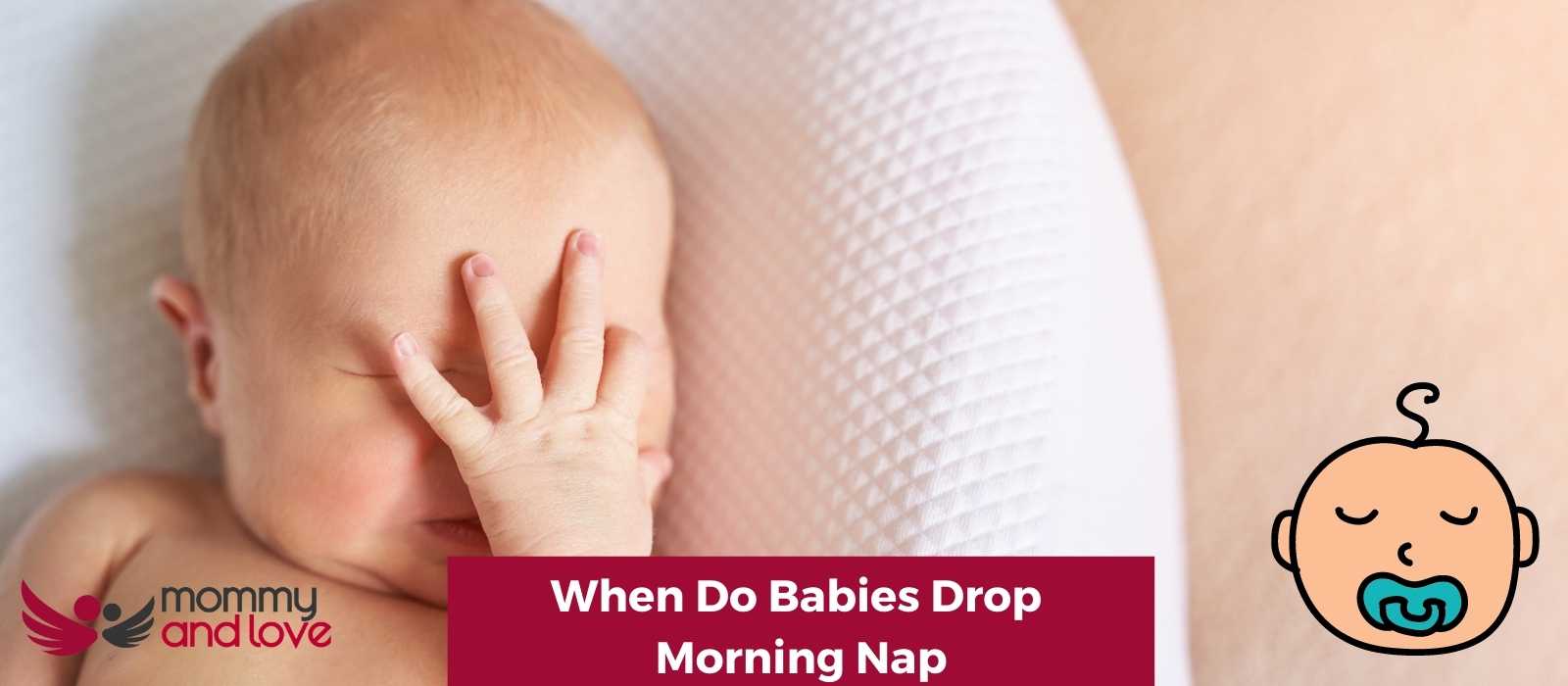Your baby should drop the morning nap at 389.5 days old…
Only joking!
But seriously, there is no one size fits all for this, every child is different.
Most babies start to drop their second nap, either the morning nap or afternoon, between the ages of 12-24 months. And most of them will drop naps altogether between the ages of 2-4 years.
How Many Naps a Day Does a Baby Need?

Newborns need time to develop their natural sleep schedules and circadian rhythms.
During the first month, they will usually spend around 16 hours a day napping and sleeping.
A newborn’s nap schedule usually happens in the form of three or four-hour naps evenly spaced between feedings. Most of them take their first nap in the early morning. And after awake windows in between sleep periods, he or she will need to sleep again.
As babies get older, they take fewer naps, eventually down to just one nap a day, and their nap schedules usually become more predictable.
What Time Should a Baby’s Morning Nap Be?
Babies usually don’t establish regular sleep patterns until they are around six months old. The morning nap is the most predictable, likely starting 1.5-2 hours after they wake early in the morning. Other daytime naps can be less predictable in timing and duration.
What Is a Nap Transition?

When your baby drops a nap, it’s called a nap transition.
There are three common nap transitions that parents often ask about: when babies drop from three naps down to a two-nap schedule, from two naps to one, and then finally when young children stop taking a nap altogether. The last transition can be particularly tricky for both the child and the parent, as it marks a huge change in how her day is structured.
When your baby has gotten into a good naptime routine, it can be daunting when things change. However, don’t fear nap transitions – they are a natural part of growing and developing.
Fewer naps can also make it easier to get out and about, especially on a busy day, and change the way parents and their children spend their days together.
What Are the Signs That a Baby Is Ready to Transition to One Nap?
There are some signs that your baby or toddler is ready to stop taking multiple naps.
- If your baby usually takes a nap every day, but suddenly starts skipping it or taking much longer to fall asleep, it might be a sign that she is ready to take fewer naps.
- It’s normal for naps and sleep to be temporarily disrupted when going through phases of development, but if you’re seeing some of these signs happening for a few days or more in a row, it might mean that a nap transition is on the cards.
- If you notice that your baby is waking up earlier than usual after a nap, it might be a sign that they’re ready to stop taking naps altogether. Sometimes babies will take shorter naps than usual when the nap is getting close to being dropped from their routine.
- Some babies don’t naturally fight or shorten the nap they are going to drop. Instead, it might be the next nap or bedtime that is affected. If they don’t need their third nap anymore, they might still take it, but they might resist going to bed.
- If they are ready to switch from two naps to one, they may still sleep well during their morning naps but refuse to take afternoon naps. In some cases, it could be the other way around.
- Babies often indicate they need a nap transition when they start waking up very early in the morning. This is because there’s only so much sleep that can fit into a 24-hour period, and if the baby is ready for changes to their daytime routine then nighttime sleep may be affected.
- If your baby is getting too much day sleep, she could be experiencing difficulty falling asleep at night. This is an indication that she is ready for one nap.
- Your baby is waking early after his usual naps.
- Another sign is that your child is getting at least 11 hours of uninterrupted sleep at night.
When Do Babies Transition to One Nap?
The average age when babies stop taking a second nap is between 12 and 24 months old. However, be aware that this transition period can often be rocky, as some toddlers are ready to drop morning naps, others the afternoon nap, and still others alternate days between napping in the morning and afternoon.
Most children start skipping the morning nap but still need it. See our 6 Month Old Naps – Nap Times & Tips guide. This internal conflict causes too much overtiredness and makes them fussier than usual which makes it hard for them to enjoy a good night’s sleep.
Additionally, transitioning to one nap schedule too early can lead to an overtired baby who takes short naps and/or wakes up frequently at night.
Generally, parents may want to hold onto two naps as long as possible. This means getting creative and capping naps so that you allow time for two naps without bedtime being pushed out too far.
As soon as a child turns one or moves to a toddler room, many daycare centers stop the morning nap. If you are wondering on daycares and sleep check out How Do Daycares Get Babies To Sleep?
And at age two, most toddlers will drop taking naps altogether. This nap resistance or resisting naps is normal and will pass in time. So, if your toddler rarely sleeps during the day or your child takes fewer naps or no nap at all, don’t worry.
How to Help Your Baby With Nap Transitions

When your child is ready, you can simply follow your child’s sleepy cues and go with the flow to make the transition to a different nap routine.
If you’re noticing that your baby or toddler is ready to drop a nap, it can be tempting to cut the nap out completely. However, you may want to approach the transition more gradually unless you are sure they don’t need the nap.
You can gradually reduce the length of your baby’s naps by 5/10 minutes every day to see how they respond. If necessary, you may also need to adjust their bedtime temporarily while they get used to this new nap routine.
When your baby is ready to move from three naps down to two, the last nap of the day will phase out, leaving your baby with morning and another nap in the afternoon.
And when it’s time to drop to one nap, most children drop morning naps, leaving the afternoon nap. This will be their only nap for the day. At this age, most babies have better night sleep, there’s no need for a morning nap time.
Dropping daytime sleep naps can be tricky for some children. They may not settle for their nap at all or start taking it later and later which can make bedtime unpredictable.
Adjust your child’s nap slightly to see how they respond. Some babies find it harder to sleep at night or start waking very early in the morning after taking a long good nap during the day. Take notes of this new baby sleep schedule.
It takes some time for babies to stop napping. It’s normal for babies to have some days when they don’t take naps at all and then on other days they take their occasional two-nap day. Some of them will be staying awake for longer and will take a shorter nap. So if your little one falls asleep during the day, let him.
During the transition, babies might need a slightly earlier bedtime (for example an hour earlier than usual) to make the transition easy for your baby to prevent them from being overtired. So consider moving your baby’s bedtime earlier than usual. Or have him take a short cat nap for no more than 30 minutes in the afternoon.
Don’t hesitate to push bedtime back by 30 or 60 minutes as an adjustment for the new child’s naps schedule.
It’s easy to panic when something changes especially to your little one’s normal nap time. Keep in mind that it’s only natural for these changes to happen because your baby is growing and developing.
Always be there for your child and provide support when he needs it. During this time, your child might struggle to fall asleep and stay asleep. He may also experience frequent night wakings and might stay awake for a long time especially if he had a long nap during the day.
How Long Does It Take for a Baby to Adjust to One Nap?

Generally, nap transitions can last for a few weeks usually between 2-4 weeks. Making the drop to one nap can be a bit challenging for your baby, but with the proper planning and patience, it can be done.
Stay the course and know that eventually, your little one will get used to this new baby sleep and nap routine.
Conclusion on When to Drop to One Nap
Most babies stop taking a second nap between 12 and 24 months old, but the transition period can often be rocky. Most children start skipping the morning nap but still need it; this internal conflict makes them overtired and more fussy than usual.
Generally, parents may want to hold onto two naps as long as possible. And also make sure that your children are still taking enough sleep during the transition.

This article was written by: Gian MIller – Full-Time Writer, Baby Whisperer & Dad of 3.
Gian spends a lot of his time writing. A self-proclaimed baby whisperer, Gian has been through it all with his own children and is passionate about sharing his hard-won wisdom with other parents. When he’s not writing or changing diapers, you can find him playing the guitar or watching baseball (or preferably both at the same time).




